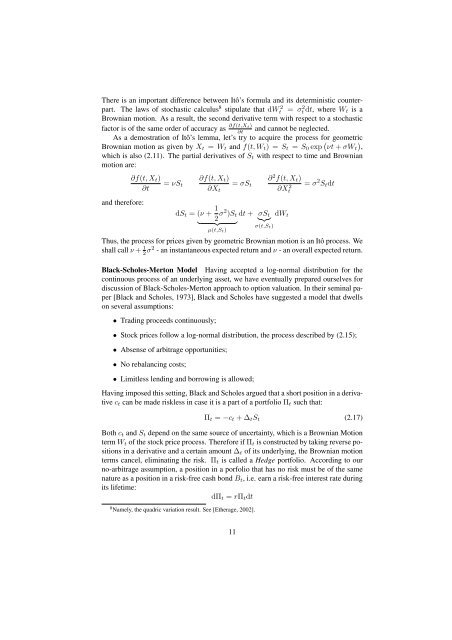sparse grid method in the libor market model. option valuation and the
sparse grid method in the libor market model. option valuation and the
sparse grid method in the libor market model. option valuation and the
Create successful ePaper yourself
Turn your PDF publications into a flip-book with our unique Google optimized e-Paper software.
There is an important difference between Itô’s formula <strong>and</strong> its determ<strong>in</strong>istic counterpart.<br />
The laws of stochastic calculus 8 stipulate that dWt<br />
2 = σt 2 dt, where W t is a<br />
Brownian motion. As a result, <strong>the</strong> second derivative term with respect to a stochastic<br />
factor is of <strong>the</strong> same order of accuracy as ∂f(t,X t)<br />
∂t<br />
<strong>and</strong> cannot be neglected.<br />
As a demostration of Itô’s lemma, let’s try to acquire <strong>the</strong> process for geometric<br />
Brownian motion as given by X t = W t <strong>and</strong> f(t, W t ) = S t = S 0 exp ( )<br />
νt + σW t ,<br />
which is also (2.11). The partial derivatives of S t with respect to time <strong>and</strong> Brownian<br />
motion are:<br />
<strong>and</strong> <strong>the</strong>refore:<br />
∂f(t, X t )<br />
∂t<br />
∂f(t, X t )<br />
∂ 2 f(t, X t )<br />
= νS t = σS t<br />
∂X t ∂Xt<br />
2 = σ 2 S t dt<br />
dS t = (ν + 1 2 σ2 )S t dt + σS t dW<br />
}{{} t<br />
} {{ }<br />
σ(t,S t )<br />
µ(t,S t)<br />
Thus, <strong>the</strong> process for prices given by geometric Brownian motion is an Itô process. We<br />
shall call ν + 1 2 σ2 - an <strong>in</strong>stantaneous expected return <strong>and</strong> ν - an overall expected return.<br />
Black-Scholes-Merton Model Hav<strong>in</strong>g accepted a log-normal distribution for <strong>the</strong><br />
cont<strong>in</strong>uous process of an underly<strong>in</strong>g asset, we have eventually prepared ourselves for<br />
discussion of Black-Scholes-Merton approach to <strong>option</strong> <strong>valuation</strong>. In <strong>the</strong>ir sem<strong>in</strong>al paper<br />
[Black <strong>and</strong> Scholes, 1973], Black <strong>and</strong> Scholes have suggested a <strong>model</strong> that dwells<br />
on several assumptions:<br />
• Trad<strong>in</strong>g proceeds cont<strong>in</strong>uously;<br />
• Stock prices follow a log-normal distribution, <strong>the</strong> process described by (2.15);<br />
• Absense of arbitrage opportunities;<br />
• No rebalanc<strong>in</strong>g costs;<br />
• Limitless lend<strong>in</strong>g <strong>and</strong> borrow<strong>in</strong>g is allowed;<br />
Hav<strong>in</strong>g imposed this sett<strong>in</strong>g, Black <strong>and</strong> Scholes argued that a short position <strong>in</strong> a derivative<br />
c t can be made riskless <strong>in</strong> case it is a part of a portfolio Π t such that:<br />
Π t = −c t + ∆ t S t (2.17)<br />
Both c t <strong>and</strong> S t depend on <strong>the</strong> same source of uncerta<strong>in</strong>ty, which is a Brownian Motion<br />
term W t of <strong>the</strong> stock price process. Therefore if Π t is constructed by tak<strong>in</strong>g reverse positions<br />
<strong>in</strong> a derivative <strong>and</strong> a certa<strong>in</strong> amount ∆ t of its underly<strong>in</strong>g, <strong>the</strong> Brownian motion<br />
terms cancel, elim<strong>in</strong>at<strong>in</strong>g <strong>the</strong> risk. Π t is called a Hedge portfolio. Accord<strong>in</strong>g to our<br />
no-arbitrage assumption, a position <strong>in</strong> a porfolio that has no risk must be of <strong>the</strong> same<br />
nature as a position <strong>in</strong> a risk-free cash bond B t , i.e. earn a risk-free <strong>in</strong>terest rate dur<strong>in</strong>g<br />
its lifetime:<br />
dΠ t = rΠ t dt<br />
8 Namely, <strong>the</strong> quadric variation result. See [E<strong>the</strong>rage, 2002].<br />
11
















